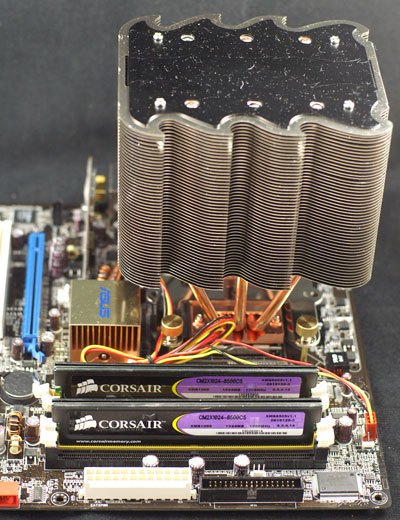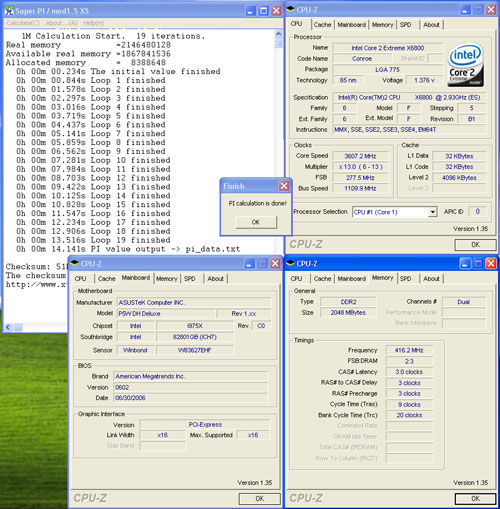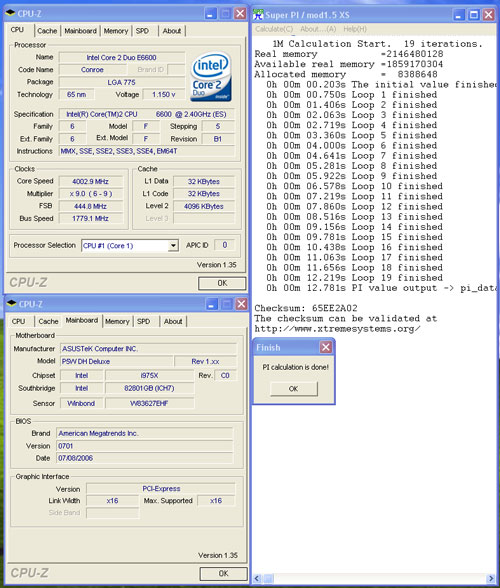Intel's Core 2 Extreme & Core 2 Duo: The Empire Strikes Back
by Anand Lal Shimpi on July 14, 2006 12:00 AM EST- Posted in
- CPUs
Overclocking
You have already seen that the Core 2 Extreme X6800 outperforms AMD's fastest processor, the FX-62, by a wide margin. This is exacerbated by the fact that the $316 E6600, running at 2.4GHz, outperforms the FX-62 in almost every benchmark we ran. That certainly address the questions of raw performance and value.
For most enthusiasts, however, there is also the important question of how Core 2 processors overclock. As AMD has moved closer to the 90nm wall, recent AM2 processors do not have much headroom. A prime example is the FX-62, which is rated at 2.8GHz, reaches 3GHz with ease, but then has a difficult time reaching or passing 3.1GHz on air. So how does Core 2, built at 65nm, compare in overclocking?
The top X6800 is rated to run at 11X multiplier on a 1066MHz FSB; it is the only Core 2, however, that is completely unlocked, both up and down. You can adjust multipliers up to 60 on the Asus P5W-DH motherboard, or down to 6. This makes the X6800 an ideal CPU for overclocking, even though top-line processors are normally notorious for not being the best overclockers.
To gauge the overhead or overclocking abilities of the X6800 in the simplest terms, the CPU speed was increased, keeping the CPU voltage at the default setting of 1.20V.
At default voltage the X6800 reached a stable 3.6GHz (13 x277). This is a 23% overclock from the stock 2.93GHz speed at stock voltage. It is also an important overclocking result, since it implies Intel could easily release a 3.46GHz or 3.6GHz Core 2 processor tomorrow if they chose to. It is clear there is no need for these faster Core 2s yet, but it does illustrate the speed range possible with the current Core 2 Duo architecture.
The X6800 was then pushed to the highest CPU speed we could achieve with Air Cooling. We did use a very popular and effective air cooler for our testing, the Tuniq Tower.

The goal was to reach the highest possible speed that was benchmark stable. Super Pi, 3DMarks, and several game benchmarks were run to test stability. The 2.93GHz chip reached 4.0GHz on air cooling in these overclocking tests. That represents a 36% overclock on air with what will likely be the least overclockable Core 2 processor - the top line X6800.
To provide some idea of overclocking abilities with other Core 2 Duo processors, we ran quick tests with E6700 (2.67GHz), and E6600 (2.4GHz). The test E6700 reached a stable 3.4GHz at default voltage and topped out at 3.9GHz with the Tuniq Cooler. The 2.4GHz E6600 turned out to be quite an overclocker in our tests. Even though it was hard-locked at a 9 multiplier it reached an amazing 4GHz in the overclocking tests. That represents a 67% overclock.
We had another Core 2 Extreme X6800 that we tried overclocking with a stock Intel HSF. The results were not as impressive as with the Tuniq cooler, with 3.4GHz being the most stable we could get it. We're going to be playing around with these processors more in the future to hopefully get a better overall characterization of what you can expect.
Curious about our overclocking successes, we asked Intel why Core 2 CPUs are able to overclock close to the same levels as NetBurst processors can, despite having less than half the pipeline length. Intel gave us the following explanation:
NetBurst microarchitecture is constrained by physical power / thermal limitations long before the constraint of pipeline stages comes into play. The microarchitecture itself would continue to scale upwards if not for the power constraints. (In fact, we have seen Presler overclocked to 6 GHz in liquid nitrogen environments. At that level, power delivery through the power supply & board itself begin to limit further scaling of the processor.)
Intel's explanation makes a great deal of sense, especially when you remember the original claims that NetBurst was supposed to be good for between 5GHz - 10GHz. NetBurst never got the chance to reach its true overclocking prime as Intel hit thermal density walls well before the 5GHz - 10GHz range and thus Intel's Core architecture was born. Intel's Core 2 processors once again give us an example of the good ol' days of Intel overclocking, where moving to a smaller manufacturing process meant we'd have some highly overclockable chips on our hands. With NetBurst dead and buried, the golden age of overclocking is back.
Enthusuasts have not seen overclocking like this since Socket 478 days, and in fact Core 2 may be even better. The 2.4GHz E6600, which outperformed the FX-62 in most benchmarks at stock speed costs $316, and overclocked to 4Ghz with excellent air cooling. With that kind of performance, value, and overclocking the E6600 will likely become the preferred chip for serious overclockers - particularly those that are looking for champagne performance on a smaller budget.
It is important, however, not to sell the advantages of the X6800 short. AnandTech never recommends the fastest chip you can buy as a good value choice, but X6800 does bring some advantages to the table. It is the only Conroe that is completely unlocked. This allows settings like 266(stock FSB)x15 for 4.0GHz, settings that keep other components in the system at stock speed. This can only be achieved with the X6800 - other Core 2 Duo chips are hard-locked - and for some that feature will justify buying an X6800 at $999. For the rest of us overclockers E6600 is shaping up to be the chip to buy for overclocking.












202 Comments
View All Comments
Kougar - Friday, July 14, 2006 - link
I wasn't sure of the B2 Stepping 6 info because it has been impossible to find CPU-Z shots of this chip, let alone anyone reviewing them!!Mostly I just want to ensure Intel doesn't pull any surprises or OC limiting with them, at this point if the B2 Stepping 6 with that last round of bugfixing performs even the same as a Stepping 5 I'd be extremely happy!
redpriest_ - Friday, July 14, 2006 - link
Thanks Wesley - my Core 2 Duo Extreme X6800 is definitely a Stepping 6, Revision B2 Conroe. It has a packaging date of July 5, 2006. I have all the multipliers unlocked, and I am stuck at around 3.466 ghz using multipliers only for stability. I am running on the Intel 975X BadAxe rev 304 with the latest BIOS.I haven't tried upping the bus from there, yet - I am using 1.4 volts; default voltage isn't dual prime 95 stable at 3.466 ghz, but is at 3.2 ghz.
I haven't tried any intermediate voltages between there to test, so it's possible my Conroe is stable at 3.466 ghz at less voltage. I'll give that a try.
Kougar - Friday, July 14, 2006 - link
What motherboard is this? Have you double-checked your RAM settings and memory ratio? I'd imagine setting a 1:1 ratio, using the most relaxed timings, and slowly ramping up the FSB would get you further. And do try less voltages... ;)That's my plan anyway, DDR2-800 memory speeds on a 1:1 ratio thanks to a 400FSB, 10x multiplier... :)
Kougar - Friday, July 14, 2006 - link
Anandtech used Engineering Sample CPUs, so they would be B0 Stepping 4 or B1 Stepping 5 only. Only retail models will be B2 stepping 6...Did you change your cpu voltage any? Sounds like you didn't ;)
redpriest_ - Friday, July 14, 2006 - link
I had to - 1.4 (1.35 real) to get to 3.466, and 1.5 to 3.733.Wesley Fink - Friday, July 14, 2006 - link
Did you OC by adjusting multipliers first? We could run the X6800 at 3.46 at 13 multiplier using stock voltage, but using 315 bus times the stock 11 multiplier required a small voltage increase. The easiest OCs used higher multipliers and modest FSB increases. The E Conroes are locked, however, and can only be overclocked by increasing the FSB.redpriest_ - Friday, July 14, 2006 - link
Yes, I tried using multipliers only, I haven't fiddled with bus speed yet.Kougar - Friday, July 14, 2006 - link
First, the X6800 is selling at NewEgg, and they are price gouging it for all it's worth. Still listed in stock after having been up for 3+ hours...What a great way to start the day... Thank you Anandtech for this great article! Supurb! Now I have to agree with the poster above me, some info on the E6300 overclocking would about round out my curiosity!
I have a question though, do y'all or anyone else have some CPUZ shots of a retail shipping Conroe? I believe this are supposed to be revision B2 stepping 6??
As for the expected skeptics, my saying the numbers appear to jive won't mean anything... so I'll just say there are over 25 reviews out now of the Core 2 Duo released today. :)
mAdMaLuDaWg - Friday, July 14, 2006 - link
I'm curious on if you tried OCing the E6300. What was the highest stable speed you were able to get.xsilver - Monday, July 17, 2006 - link
for those who dont want to read the xbit labs articlethe overclocking of the e6300 is limited by the motherboard - eg. cant get the board to boot at any higher than 420mhz fsb
we may have to wait for nvidia's core2 solution to see higher fsb's